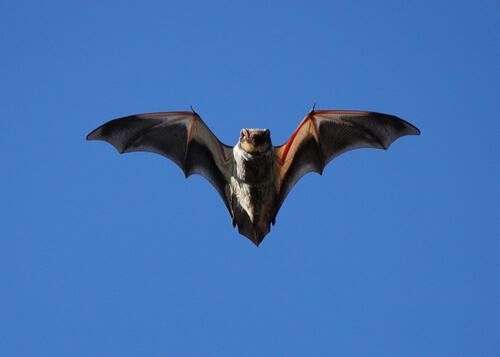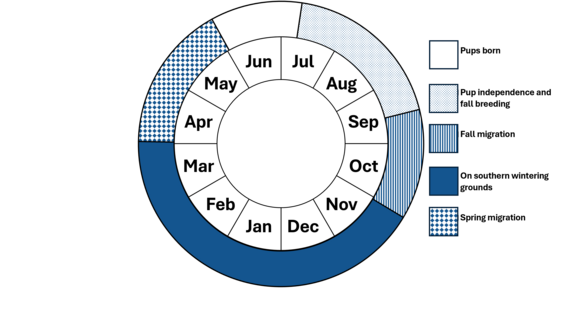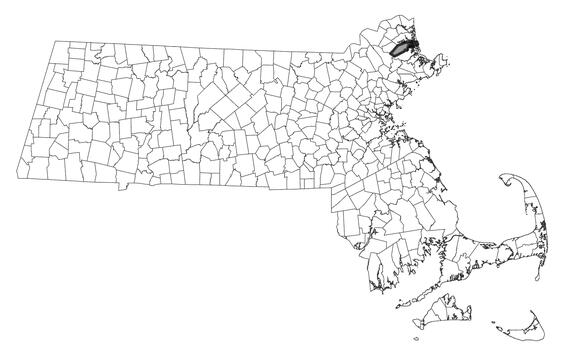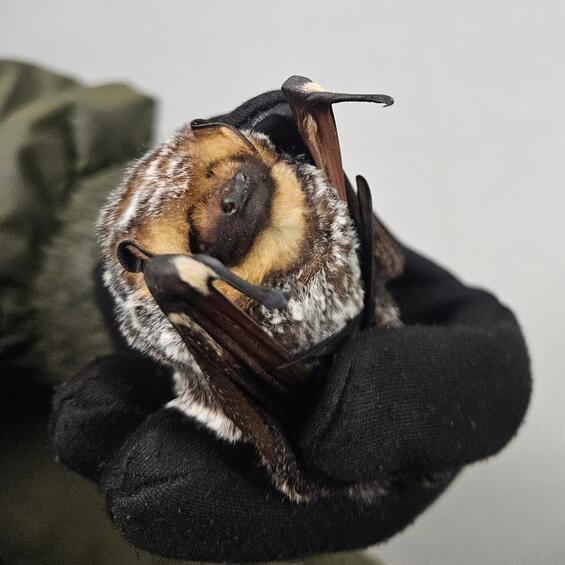- Scientific name: Lasiurus cinereus
- Species of Greatest Conservation Need (MA State Wildlife Action Plan)
- Special Concern (MA Endangered Species Act)
Description

Hoary bat (Lasiurus cinereus)
The hoary bat is the largest bat found in Massachusetts. It measures 102-152 mm (4 to 6 in) in total length and 17-40 g (0.6 to 1.4 oz) in weight. Females are about 4% larger than males. The forearm length is 42-59 mm (1.6 to 2.3 in). The wingspan can reach nearly 425 mm (17 in). The fur of hoary bats is yellowish-brown to dark mahogany brown, each hair tipped with silver. When parted, there are four bands of color on each guard hair. All three species of tree bats have well-furred tail membranes, and short, rounded, well-furred ears.
Similar species: The other two species of tree bats in Massachusetts are the red bat and the silver-haired bat. Both species are smaller and have a different color pattern than the hoary bat. Unlike most species of bats that have an erratic flight pattern, hoary bats have a strong, rapid and straight flight that can reach up to 97 kph (60 mph).
Life cycle and behavior
Hoary bats are usually solitary, occurring together only to mate and care for their young. They may also be loosely drawn together while feeding and during migration. Like neotropical migrant songbirds, the tree bats migrate south for the winter, returning north in the spring. The peak of fall migration is in August and September. The spring migration north is from April to June.
All three of the Massachusetts tree bats have four mammae, but the hoary bat usually only gives birth to two pups, born from late May to early July. For their first 17 days, the pups are carried by the mother, after which they are left to roost on their own in trees. The average lifespan is believed to be about 6-7 years but can extend to at least 14 years.

Population status
The hoary bat was listed in Massachusetts as a species of special concern in 2024, based on concerns for the species globally and regionally. Evidence suggests that all three species of tree bats have been declining in the Northeast. Since they do not emerge until well after sunset, fly high and fast, and live singly, hoary bats are not well reported.
Distribution and abundance
Hoary bats are widely distributed in North America, being found from in all 48 contiguous states, as well as the spruce forest of Canada and south through much of Mexico. Although hoary bats have only been documented in 55 of 351 Massachusetts municipalities, from 12 of the 14 counties, they probably occur statewide.

Distribution in Massachusetts in 2000-2025 based on records in the Natural Heritage Database.
Habitat
Hoary bats are most often associated with coniferous forests, but they are also found in woodlands, farmlands, fields, over ponds, and in residential neighborhoods with mature trees. They may be best seen, as they come to ponds to drink and forage. They roost solitarily among thick leaves of trees or occasionally in tree cavities.
Healthy habitats are vital for supporting native wildlife and plants. Explore habitats and learn about conservation and restoration in Massachusetts.
Threats
As for most other tree bats, hoary bats are threatened by the precipitous decline in larger moths due to parasitism by the non-native wasp, Compsilura concinnata. Declines in other prey species, due to insecticide spraying or prey species habitat destruction may present additional challenges. Hoary bats are found dead under wind turbines more than any other North American Species of bat. Across North America, the majority of bats killed at wind towers are migratory tree bats.
Conservation

Hoary bat (Lasiurus cinereus)
It is important to develop a better understanding of the causes of mortality at wind towers and to develop methods to reduce or avoid them, including adjustments to turbine design and operation. Long-term monitoring of bat mortality at wind towers is needed.
All listed species are protected from killing, collecting, possessing, or sale and from activities that would destroy habitat and thus directly or indirectly cause mortality or disrupt critical behaviors. In addition, listed animals are specifically protected from activities that disrupt nesting, breeding, feeding, or migration.
References
Shump, K.A., Jr. and A.U. Shump. 1982. Mammalian Species 185:1-5.
van Zyll de Jong, G.G. 1985. Handbook of Canadian Mammals, Vol. 2 Bats. National Museums of Canada. 212 pp.
Whitaker, J. O., Jr., and W. J. Hamilton, Jr. 1998. Mammals of the Eastern United States. Third edition. Comstock Publishing Associates, Ithaca, New York. 583 pp.
Contact
| Date published: | March 4, 2025 |
|---|